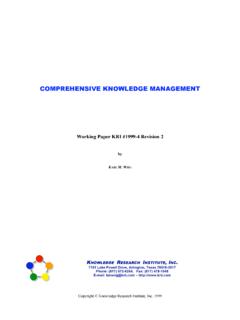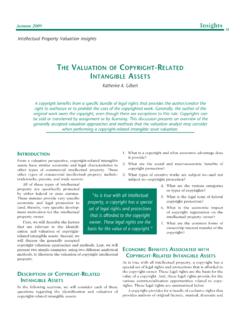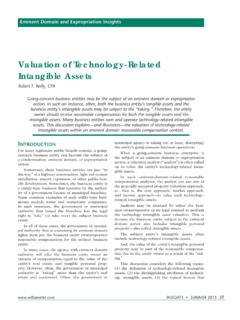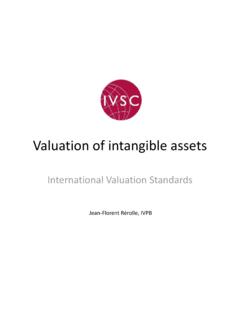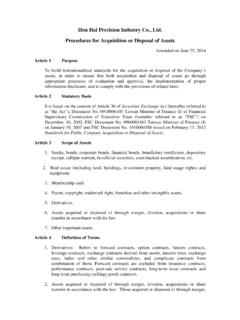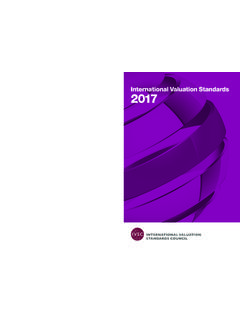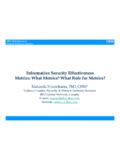Transcription of Knowledge Management The Central Management Focus …
1 Knowledge ManagementThe Central Management FocusforIntelligent-Acting OrganizationsKarl M. Wiig SCHEMA PRESSA rlington, TexasPublished and Distributed bySCHEMA PRESS, Vicksburg DriveArlington, TX 76017 Phone: (817) 572-6254 Fax: (817) 478-1048E-mail: 1994 by Karl M. WiigAll rights reserved. Printed in the United States of America. No part of this material may be reproduced or transmitted in any form or by any means, electronic or mechanical, including photocopy, recording, or any information storage and retrieval system without permission in writing from SCHEMA PRESS, 0-9638925-1-7 Library of Congress Catalog Card Number: 93-92804 The three volumes in this series are:Volume 1 Knowledge Management Foundations-- Thinking about Thinking --How People and Organizations Create, Represent, and Use KnowledgeISBN 0-9638925-0-9 Library of Congress Catalog Card Number: 93-92803 Volume 2 Knowledge ManagementThe Central Management Focus for Intelligent-Acting OrganizationsISBN 0-9638925-1-7 Library of Congress Catalog Card Number.
2 93-92804 Volume 3 Knowledge Management MethodsPractical Approaches to Managing KnowledgeISBN 0-9638925-2-5 Library of Congress Catalog Card Number: 93-92802 Three-Volume Set ISBN 0-9638925-3-3 Printing: 2 3 4 5 6 7 95 96 97 98 ContentsPageContentsAcknowledgmentPrefac ePart I. The Role of Knowledge in BusinessChapter 1. The Knowledge Focus : A New Perspective for Effective BusinessesManaging Knowledge Is VitalKnowledge, Its Management , and the Intelligent-Acting OrganizationWhy Are Intelligent-Acting Organizations Desirable?What Is Required to Be Intelligent-Acting?What is Knowledge Management ?How Can Knowledge Management Make the Organization More Intelligent-Acting?Do More with Less! -- Use Knowledge !
3 The Value of Knowledge -- A Beginning PerspectiveThree Themes of Knowledge Management1. Knowledge Is the Foundation of the Whole Enterprise2. Knowledge Management Must Make the Enterprise Intelligent-Acting3. The Best Knowledge Must Be Embedded into All Products and ServicesWhy Should I be Concerned with Knowledge Management ?Example: Find and Manage the Most Important Knowledge AreasExample: Conduct Strategic Knowledge Audit to Change Corporate Structure and DirectionExample: Build a Knowledge -Based System to Exploit the Value of Proprietary KnowledgeThree Pillars of Knowledge ManagementHow Much Should an Organization Know about KnowledgeKnowledge Work Changes our Business EnvironmentKnowledge Can be Managed Effectively Knowledge Management Requires New Methodologies and PerspectivesApplications of Knowledge ManagementApproaches to Exploiting Knowledge Chapter 2.
4 Executive Perspectives on the Importance of KnowledgeA Survey of Executive Perspectives on Knowledge and Its ManagementCompany Goals and CompetitivenessImportance of KnowledgeOn Knowledge ManagementHow should Knowledge Management be Organized?Organization and Human Resources Knowledge Technology and Knowledge -Based SystemsImportance of Knowledge Management ActivitiesConcerns of Many Executives Related to Knowledge ManagementChapter 3. Knowledge Is Needed Everywhere!Of Course, Knowledge Is Needed!Expertise Is Needed for Quality Work Clerical Work Requires Considerable ExpertiseThe Outstanding Performer s Mental ModelsThe Danger Plateau of Up-and-Coming Knowledge WorkersDistinction Between Knowledge and Information Is Not Always ClearWhat Does It Mean?
5 The Struggle to Interpret InformationWhat Is the Meaning behind the Information? Agile Manufacturing Needs KnowledgeExamples of Practical Approaches to Knowledge ManagementDetailed Analysis of Knowledge -Intensive WorkKnowledge, Skills, and Personal Characteristics ProfilesTeach Concepts to Build Knowledge , Rather than Merely Training to Transfer Facts and Create SkillsWhat Can the Computer Know and What Must the Human Know?Chapter 4. American Knowledge GapsKnowledge Gaps Come in Different FormsWhy Do Knowledge Gaps Matter?The American Knowledge Gap Is Two-SidedSome Knowledge Gap ExamplesBudget Cutting May Lead to Detrimental Knowledge GapsDo Not Transfer Work to the Field without the Accompanying KnowledgeAutomating without Adding Knowledge Can Be CostlyDangers of Technology Transfer Without Underlying KnowledgeThe Myth of the Communication Gap Are American Knowledge Gaps Long-Term or Temporary?
6 Education and Knowledge Preparedness in and Other CountriesKnowledge Gap Between Workers and Workplace RequirementsAre the Knowledge Gaps Changing?Workplace Sophistication Continues to Increase!What Can Be Done about the Knowledge Gaps?Japan s Meta-Cognitive Firms and EnterprisesChapter 5. Business Approaches to Knowledge ManagementWhy Companies Decide to Pursue Knowledge ManagementKnowledge Management Is Approached from Many PerspectivesKnowledge Management Focus Is Driven by NeedsManagerial Motivations for Initiating Strategic ChangesExecutive Managers Must Be Provided with Understanding and ConvictionKnowledge Management -- State-of-the-ArtDynamics of Introducing Knowledge Management Adoption of Knowledge Management Will Be Slow Strategic Aspects of Introducing Knowledge ManagementCompetitive Advantages of Knowledge and Its ManagementBuild Knowledge for the FutureBuild and Distribute Knowledge for Improved Internal OperationsEmbed Knowledge in the Infrastructure!
7 Other Strategic PerspectivesOpportunities for Managing KnowledgeMany Managers Choose the Easy Way Out! Knowledge -Related Costs of Firing and Rehiring: Lack of Knowledge ManagementCan Be CostlyChapter 6. Benefits from Active Knowledge ManagementBenefits May Be Substantial! Competitive Advantages of Knowledge and Its ManagementEconomics Aspects of KnowledgeThe Broader PerspectiveSmartly Applied Knowledge Makes Our Lifestyle Possible without Exploiting the Less Fortunate!Supply and Demand of Knowledge -- Value of Scarce KnowledgeSocietal Knowledge FlowsValue of KnowledgeEconomics of Knowledge TransferKnowledge Assets Are Not on the Balance Sheet! They Are Not Managed and Often Wasted!Benefits from Using Knowledge Marginal Economics of KnowledgeWe Apply Knowledge to Work ObjectsKnowledge and Noneconomic ObjectivesTangible and Intangible BenefitsEvaluating the Benefits from Active Knowledge Management Direct and Indirect BenefitsKnowledge FlowsPart II.
8 Shape The Future!Chapter 7. Knowledge Management Opportunities and Issues Management s Role in Knowledge Management Many Areas Need Senior Management InvolvementKnowledge Management Occurs on Three LevelsCorporate Knowledge AssetsWhat Is Included in Knowledge Assets?Professional Knowledge and Skills Can Be CategorizedTotal Knowledge Assets in a Department and Cumulation of InvestmentsOn Management of Knowledge AssetsThe Scope of Knowledge asset ManagementKnowledge asset Management IndicatorsWhat Does It Mean to Use Knowledge Effectively?How Can We Monitor Knowledge asset Management ?There Is a Problem with IndicatorsPerformance Measures for Knowledge asset Management .Examples of Potential Knowledge asset Management MeasuresMeasuring Returns on Knowledge AssetsBook Value of Knowledge -- Capitalization of Knowledge AssetsValuation of Inventions, Patents, and Unique Products and Their ByproductsDepreciation of Knowledge -- Real and Accounting Life of KnowledgeThe Clincher of ROKA -- Estimating Returns from Use of KnowledgeReturn on Knowledge Assets Alone Is Inappropriate.
9 The Chief Knowledge OfficerThe Chief Knowledge Officer s Scope .Potential Charter for the Chief Knowledge OfficerA Tall Knowledge Management Planning Framework . Knowledge Management Is Integral to Other ActivitiesManagement Initiatives and Knowledge Management .Learning Organization Initiative .Business Process Redesign Initiative .Organizational Architecture InitiativeTime-Based Competition InitiativeCore Competencies InitiativeTotal Quality Management InitiativeFunctional Areas of Knowledge Management .Human Resource Management and Knowledge Management .Education and TrainingAn Important Caretaking FunctionHiring and Personnel DevelopmentPersonnel EvaluationChapter 8. Starting a Knowledge Management ProgramThe First Important StepsHow Large a Commitment Do I Want, or Need, to Make?
10 The Small-Effort Approach to Introducing KMObtain Overview of the General State of KnowledgeAssemble Overview of Knowledge -Related Activities and FunctionsIdentify and Conceptualize Knowledge -Based System Candidates Build Knowledge -Based System for Particular Business FunctionCreate Skill Inventory to Build Better Teams and Fill Knowledge GapsImplement Lessons Learned SystemsCollect Knowledge from Departing and Promoted ExpertsPerform Selected Knowledge Audits Undertake Strategic Planning for Knowledge ManagementPrudent, Intermediate-Sized Approach to Introducing KMCoordinate Knowledge -Related Programs and Activities Change the Organization to Become a Learning OrganizationTransfer a Broad Knowledge Area to Organizationwide Points-of-ActionOrganize a Coordinated Knowledge -Transfer CapabilityFind and Alleviate, or Exploit, All Significant Critical Knowledge FunctionsInitiate Corporatewide Knowledge asset ManagementComprehensive.
